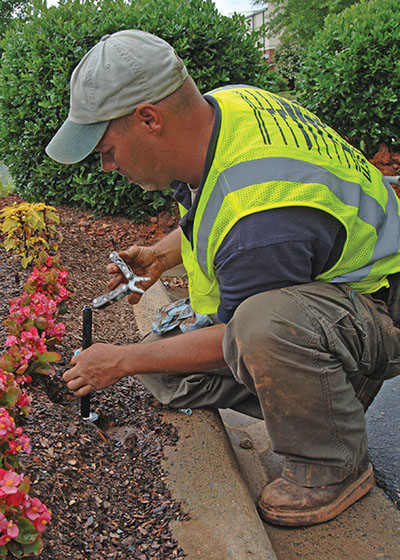Protecting your property with a properly winterized landscape.
Properly winterizing a facility’s irrigation system and plantings is a cost-effective way to protect a property and its grounds from severe damage during the winter months. Failure to winterize can cause costly headaches to facility owners and managers. Correctly winterizing the irrigation system will help increase the life of pipe fittings, sprinklers, valves, pumps, pipes and other parts of irrigation systems. Winterization also includes preparing the vegetation on the property for the colder months. There are a variety of cost-effective steps property owners and managers can take to guarantee that the property is properly maintained through the winter and to ensure that it is spring-ready.
The benefits of winterizing an irrigation system far outweigh the costs that can accompany such work. Properly draining and blowing out pipes can save an irrigation system from a host of potential problems. Irrigation pipes that have frozen are likely to burst and cause leaking or flooding when the ice melts. Replacing burst pipes is not just a hassle — it can also be extremely expensive.
Burst pipes due to residual water freezing remains the most expensive consequence of improper winterization. Freezing water expands roughly 9%, which can easily cause the cracking or breaking of pipes. Broken irrigation systems, in turn, can cause flooding and water damage to structures. Most irrigation systems can be cleared of water by simply shutting off the water supply, opening all valves and faucets and allowing water to drain out. Water features such as fountains, ponds or waterfalls, however, should remain running throughout winter. In the coldest areas, water features should be drained to prevent frozen water from bursting in the motor. If a water feature is drained, the motor should be removed and stored in a warm area submerged in water to prevent cracking of seals.
For properties with more complex irrigation systems, blowing out pipes using compressed air tanks may be necessary to prevent damaged or burst pipe lines, fittings and valves. Blowing out pipes can remove remaining pools of water from irrigation ‘valleys,’ lower areas where, without pressure, water would settle and freeze. In some cases, valve traps will hold a small amount of residual moisture even after being blown clean. Adding small amounts of anti-freeze solution to valve traps can help keep them from freezing.
 Properly preparing a property’s vegetation for winter can also help save money and curb potential spring stresses. Digging out plants that cannot weather the drop in temperature and fortifying those that stay in ground saves on annual plant replacement costs. This simple process also aids in deterring pests from attacking garden beds.
Properly preparing a property’s vegetation for winter can also help save money and curb potential spring stresses. Digging out plants that cannot weather the drop in temperature and fortifying those that stay in ground saves on annual plant replacement costs. This simple process also aids in deterring pests from attacking garden beds.
Maintaining a healthy winter landscape should begin with the clearing of dead plants and debris. Dethatching, by removing organic debris that settles around grass blades, will keep away pests and parasites that could otherwise harbor there, infecting nearby plants, flowers, trees and shrubs. Debris should be cleared after a hard frost to ensure plants will not start growing again. If plants do start to grow again, they should be cut back to force winter hibernation. Because so much of a plant’s energy is put into leaves and flowers, plants that have been cut back will be forced to focus on heating the core of the plant and keeping the roots alive through freezing ground temperatures.
Additionally, many varieties of flowers cannot withstand a frost and many more die out simply from the cold. Ensuring a landscaped garden is left undisturbed throughout the winter season requires following a few simple steps. First, bulbs that cannot withstand a freeze should be dug out and left in a cool, dark space to wait out the winter. Allow bulbs to dry on newspaper for a period of 2 weeks to prevent rotting and place them evenly spaced in a cardboard box or clay pot. This will decrease spreading, if rot should occur. The bulbs should then to be covered to deter new growth. Covering materials, such as peat moss, pearlite, vermiculite, sawdust or sand work best because they allow for healthy ventilation.
For bulbs that can withstand the cold — or even freezing — temperatures, a few key steps can be taken to ensure they are prepared for the coldest of weather. Bulbs left in the ground over the colder months should be kept under cover, allowing them to withstand lower temperatures than they are traditionally meant to weather. Applying a layer of clean mulch over a hard frozen ground will insulate garden beds and raise the internal temperature of the bulbs left there. Additionally, a layer of compost should be added every few weeks for extra ‘burn heat’ during the coldest times.
Ensuring that an irrigation system is properly drained, that the proper lawn care maintenance techniques are utilized and that bulbs are protected are some the easiest and most cost-effective methods for property winterization. Working closely with a lawn care specialist will help prevent damages and expenses caused by burst pipes, diseased lawns or rotted plants. Following these simple, yet crucial, steps will help a property survive the winter and emerge healthy in the spring.
— Mike Fitzpatrick is vice president of U.S. Lawns, one of the commercial landscape industry’s largest companies with approximately 255 franchise locations nationwide. The author may be reached at [email protected].
